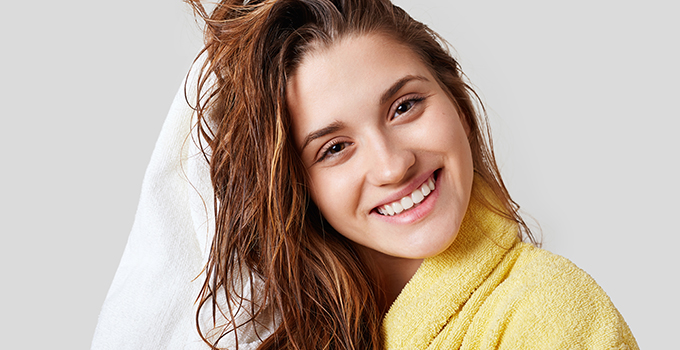
Why do we use conditioner?
You too probably use conditioner in your hair routine. But why do we actually use conditioner? And is it really necessary? In this blog, we will explain what conditioner is, what it does for your hair and which ingredients to look out for when choosing a conditioner.
What is a conditioner?
Conditioner is an important part of caring for your hair. A conditioner is often a rinse that you generally use after washing your hair. A shampoo cleans your hair (from sebum, styling residues, dirt, etc.) and also opens your hair cuticles (especially if it contains sulphates). This allows the hair to be spotless and the caring and nourishing substances of the shampoo to penetrate deep into the hair. A conditioner gives your hair extra care and closes the cuticles again. If you do not use a conditioner, your hair cuticles will remain open due to shampooing. This allows the conditioning ingredients to escape and also allows the colour to fade faster when you dye your hair.
What does a conditioner do?
Using a conditioner has several benefits for your hair:
- It closes your hair cuticles: a conditioner closes your hair cuticles again after washing. This keeps your dyed hair colour looking beautiful for a longer time. Hair in which the cuticles do not close properly has more trouble retaining pigment, causing the colour to fade faster. Your hair can also dry out because it loses moisture faster when the cuticles are open.
- Protection: conditioner also creates a soft protective layer around your cuticles. It protects your hair from external factors such as heat tools, brushes, sun and wind.
- Shine: conditioner restores shine to your locks and reduces frizz. This makes your hair look prettier and healthier.
- Softness: it makes your hair soft, supple and easier to comb. Tangles and knots in your hair become less likely. This prevents damage and split ends.
- Hydration: a conditioner helps to restore the hair's moisture balance: your hair is nourished and hydrated.
- Prevents static: dry hair tends to get static faster. A conditioner nourishes your hair, softens it and makes it less dry and therefore: less static.
What is the difference between a conditioner and a hair mask?
A hair mask, like a conditioner, also closes the hair cuticles after washing. Yet, there is a clear difference between a conditioner and a hair mask. The most obvious difference is the texture. In fact, a hair mask is often a lot thicker than a conditioner; this is mainly due to the amount of water in the product. Hair masks are a lot more concentrated because they contain a lower percentage of water. This allows a hair mask to penetrate deeper into the hair and moisturise and nourish it even more than a conditioner. Also, just like a conditioner, it puts a protective layer around your hair to prevent split ends and damage. It is therefore not necessary to use both a conditioner and a hair mask after washing your hair; one of these products is all you need.
You generally do not use a hair mask more than once a week, unlike the conditioner that you apply after every wash. This is because a mask can weigh your hair down and, as a result, it will no longer hold its shape if you use it excessively.
How to use a conditioner?
You generally massage a conditioner into your hair after shampooing. Do this only in the ends of your hair, though. If you apply it to your scalp or hair roots, your hair follicles may clog up, and your hair will become oily faster.
It is important to squeeze the excess water out of your locks after shampooing before applying conditioner. This way, the conditioner can do its job better and the ingredients can be properly absorbed into the hair. Generally, two minutes is enough for your conditioner to be absorbed, but it can vary per brand and type. So read carefully what it says on the packaging of your conditioner. You can use conditioner after every wash.
Ingredients to avoid in conditioner
With a wide range of conditioners available in shops and online, it might be difficult to choose a conditioner. Therefore, pay close attention to the product's formulation and ingredient list. Avoid ingredients like silicones and sulphates in your conditioner. These make your hair look smoother, softer and healthier, but have negative long-term effects on your hair.
Silicones in conditioner
You can think of silicones as a kind of liquid plastic. They form a protective layer around your hair. This makes your hair softer, smoother and easier to comb. There are water-soluble and non-water-soluble silicones. The name says it all: water-soluble silicones can be removed with water. Non-water-soluble silicones, on the other hand, are not easily washed out of your hair. You need an aggressive shampoo for that, and you want to avoid those. If you do not use an aggressive shampoo, you end up with a build-up. This means several layers of silicones build up in your hair, which can make it heavy and lifeless. Especially if you have curly hair, this can be a real villain to your curls. It also prevents conditioning ingredients from reaching your hair.
When looking at the ingredient list, pay attention to the following terms: Behenoxy dimethicone, Cetyl dimethicone, Cetearyl methicon, Propyl dimethicone, Stearoxy dimethicone, Stearyl dimethicone and Polydimethylsiloxane. This is a sample of all the different silicones out there. You can usually recognise silicones by words ending in -cone, -conol or -siloxane.
Sulphates in conditioner
Sulphates are mainly used in detergents and cleaners, but they are also sometimes found in conditioner. They dissolve fats and oils very well, but they also remove the natural sebum and oils your hair and scalp need. This can leave you with a dry, itchy or irritated scalp. It can also dry out your hair and damage it faster.
When looking at the ingredients list, note the following terms: SLS (Sodium Lauryl Sulphate), SLES (Sodium Laureth Sulphate), ALS (Ammonium Lauryl Sulphate) and ALES (Ammonium Laureth Sulphate). You can usually recognise sulphates by words ending in -ate.
Parabens in conditioner
Parabens are found in many cosmetic products (including conditioners) and have excellent preservative properties, thus giving products a long shelf life. Yet, few substances have such a negative association as parabens. For instance, parabens have been in the media negatively for some time, with parabens being linked to the development of breast cancer. Unjustified, according to Dutch KWF Kankerbestrijding (Cancer foundation) and the Dutch Food and Consumer Product Safety Authority. However, scientific research does not show any link between the use of parabens in cosmetic products and breast cancer. So, parabens don't affect the condition of your hair that much, but still, it might not make you feel completely comfortable.
When looking at the ingredient list, note the following terms: Methylparaben, Ethylparaben, p-Propylparaben, Isobutylparaben, n-Butylparaben and Benzylparaben.
WECOLOUR conditioner: without silicones, parabens and sulphates
Free of silicones, sulphates, parabens and microplastics, WECOLOUR's conditioner has been specially developed to give extra care to dyed hair and keep the colour beautiful for longer. Why do we use conditioner? A conditioner hydrates, nourishes and rebalances hair after dyeing. The conditioner is highly concentrated, so you don't need much of it and can therefore use it for longer.
